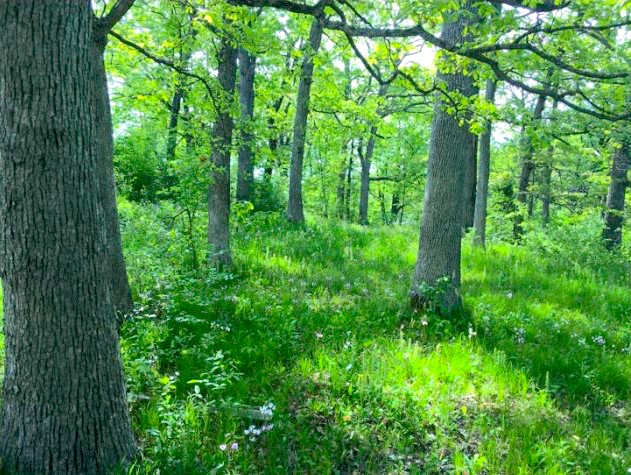The site was richer than any of us had seen. Do we need to revise our understanding of the potential natural biodiversity of white oak woodlands? Almost all sites we conserve and protect may be badly degraded. Our goals for management and recovery may be much too low.
The Wisconsin site, Army Lake Woodland, was recognized by botanist Dan Carter to have a substantially more diverse and conservative herbaceous community than he found anywhere else in southeastern Wisconsin, perhaps in Wisconsin as a whole. Rare conservative and other uncommon species are dense and diverse under an oak canopy that ranges from perhaps 60 to 80%. This site is now being used by the Wisconsin Department of Natural Resources (WDNR) and others to develop new oak woodland assessment tools.
The site is only about 1.6 acres and was formerly a semi-island. If this find is as important as it seems, a likely reason is that a tamarack swamp separated it from adjacent uplands, and for that reason it escaped the heavy grazing that degraded the biodiversity of most woodlands. The intervening marsh is narrow enough and flammable enough that prehistoric fires could well have spread across or jumped it. But the site has not been known to burn in recent years. The dense diversity may have been sufficient to slow the invasion by brush. But it’s small. And .3 acres of it are now a boat launch. More than half of the remainder is now brushy with a mix of invasive and possibly naturally occurring young trees and shrubs. An anticipated program of restoration management may yield additional species, knowledge, and insights. (*See Endnote 1 for the full species list, as it stands.)
Most woodlands today, if they have any quality at all, impress people who care about biodiversity by their dense displays of spring ephemeral flora. In contrast, Army Lake Woodland has a dense, diverse spring, summer, and fall flora that is principally not ephemeral. In May, the dominant vegetation includes Penn sedge, yellow stargrass, robin’s-plantain, running savanna sedge, wood betony, blue-eyed grass, low false bindweed, sky-blue aster, and wood rush. (See Endnote 2 for scientific names of species mentioned here.)
 |
Most of the diversity on the island survives where the growth of brush has been limited, perhaps by the intense competition of diverse grasses and wildflowers. |
Looking toward the future, DNR staff and others recently visited this and other sites as they considered revising the standards by which woodlands are evaluated and prioritized for biodiversity conservation. For the draft evaluation form they worked on, see Endnote 3. There was a consensus that this was an important woods, deserving brush control and prescribed fire.
Considering what many perceive to be the importance of the site, this blog hopes to cover the impact of anticipated upcoming brush control, burning, and other conservation efforts.
Other views of the rich flora of Army Lake Woodland are below.
 Blooming in the center of this photo is the wood pea (Lathyrus ochroleucus) with its cream-colored blossoms. This formerly common open woodland species is now Threatened in Illinois and Endangered in Indiana. Also in bloom here are wood betony (yellow), shooting star (white), and wild geranium (pink).
Blooming in the center of this photo is the wood pea (Lathyrus ochroleucus) with its cream-colored blossoms. This formerly common open woodland species is now Threatened in Illinois and Endangered in Indiana. Also in bloom here are wood betony (yellow), shooting star (white), and wild geranium (pink). This post was written by Stephen Packard (this blog's editor) and by Dan Carter of The Prairie Enthusiasts, a highly-respected organization that acquires land, provides stewardship, and advocates for the biodiversity.






What are the mean-C and Floristic Quality Index (FQI) values for the Army Lake Woodland site, particularly as compared with their calculations for other woodland sites of high quality?
ReplyDeleteMy abundance-weighted Mean C from a timed meander survey there was 5, which is very high, though very degraded sites can easily score above 4 where the overstory is white oak and the ground layer has been shaded out but sparse northern and shining bedstraw are scattered beneath exotic shrubs.
DeleteKirk, thanks for the question. But I fear that the answer might not tell us much. If anyone wants to do the computation, they could do it from the plant list in Endnote 5 of the Vestal Grove version of this post. Bigger areas tend to have higher FQI ratings. This woods is a fraction of an acre. And the remnant very high-quality parts are just patches. Mean C also might not help much here - unless you limited it to the quality areas - as much of the island is a weed patch as a result of bulldozing and recreational use. What makes this island so compelling is the density and diversity of conservative species in those pockets not degraded by brush. What would be helpful might be to a) cut the brush, b) burn for a few years, and c) then to per/quarter/meter sampling to compare with our other best quality sites.
ReplyDeleteThis is Dan. My weighted mean C from timed meander was 5. Part of the reason we are developing a course metrics assessment for woodlands in WI is that it's still possible to get high weighted mean C scores where the ground layer is almost thinned to nothing due to shading, but that almost nothing includes northern bedstraw, shining bedstraw...and at mesic sites wetland species with moderate C-values like Boehmeria will start to come in.
ReplyDelete